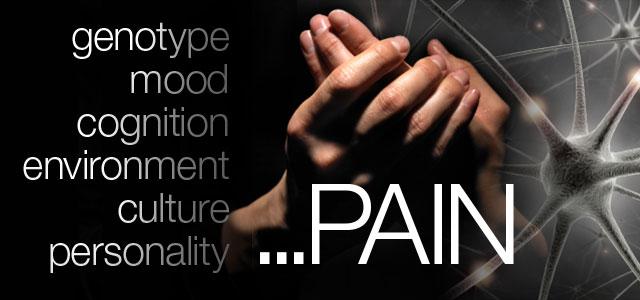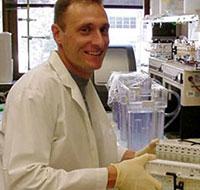
Pain Studies Enhance Precision Medicine
In the 1980s, Christine Miaskowski was working as a clinical nurse specialist in a pain management center at the University Hospital of the Albert Einstein College of Medicine in New York.
“One day this woman walked in who couldn’t move her shoulder,” says Miaskowski. “She talked about the pain she’d experienced since her radical mastectomy, about how her surgeon kept telling her she was healed, and how she’d been hospitalized in a psychiatric institution as a crazy postmenopausal woman. She said if we didn’t help her, she would kill herself. We were able to tell her she wasn’t crazy – we knew the pain was real, a neuropathic, postsurgical pain syndrome – but as we began to explore these cases, nearly every surgeon I called told us this wasn’t a real problem for their patients.”
Her patients’ ordeals and that of Miaskowski’s own father – “who died in intractable pain from this same postsurgical syndrome” – have driven a career that has made Miaskowski an internationally respected pain researcher.
In December 2012 her work came full circle, when she and a diverse team of experts published the results of a major study in The Journal of Pain. The work established that after breast cancer surgery, about 25 percent of women experience persistent breast pain and 35 percent of women experience persistent arm and shoulder pain.
 Christine Miaskowski “It’s rewarding to complete that work,” says Miaskowski, now the associate dean for Academic Affairs at UC San Francisco School of Nursing, American Cancer Society Clinical Research Professor, Sharon A. Lamb Endowed Chair in Symptom Management Research and co-director of the Research Center for Symptom Management, one of the only such centers housed at a school of nursing in the country.
Christine Miaskowski “It’s rewarding to complete that work,” says Miaskowski, now the associate dean for Academic Affairs at UC San Francisco School of Nursing, American Cancer Society Clinical Research Professor, Sharon A. Lamb Endowed Chair in Symptom Management Research and co-director of the Research Center for Symptom Management, one of the only such centers housed at a school of nursing in the country.
The rewards may grow if the research team she has assembled with her primary collaborator, geneticist Bradley Aouizerat, can show that incorporating genomics into a much broader group of potential factors – including environmental and psychosocial components – can help clinicians better understand which patients are at greatest risk for persistent postsurgical pain and how to better prevent or treat it. The result would be an important refinement and broadening of the precision medicine concept, which could in turn reduce a considerable amount of human suffering and billions of dollars in health care costs.
100 Million People with Persistent Pain – And Few Effective Therapies
According to a 2011 report from the Institute of Medicine, 100 million Americans live with persistent pain, the treatment of which costs $635 billion every year in medical bills and lost productivity. The report was a culmination of how awareness of persistent pain as an important medical condition has grown over the last decade or so.
In the aftermath of the IOM report, Miaskowski was named one of six nonfederal scientists – and one of only three nurses – to a federal Interagency Pain Research Coordinating Committee, which is dedicated to improving pain research and patient care. In addition, UC San Francisco recently became one of 12 National Institutes of Health Centers of Excellence in Pain Education, dedicated to making sure clinicians and those training to be clinicians are aware of best practices in pain management.
But treatment options remain limited. Despite a decade of scientific discoveries about the mechanisms, pathways and role of psychology in persistent or chronic pain – as well as advances in diagnostic tools and clinical breakthroughs in specific areas, like headache – for many types of chronic pain, effective therapies remain elusive. Highly publicized concerns about the addictive properties of opiates, one of the few known effective therapies for certain types of pain, have further constrained clinicians’ options.
In the case of breast cancer, the theory is that postsurgical pain results from nerve injury. Thus the general wisdom is to try an anticonvulsant, but in Miaskowski’s recent study, the most widely prescribed medications were antidepressants.
“Very few of these women were on analgesics, and we don’t know why,” she says.
“We’ve long appreciated the pain problems.… I’ve always tried to listen to patients and anticipate…but doctors are different, and there may be surgeons who don’t have the same appreciation of these patients’ experience,” says breast surgeon Charles Elboim of the Redwood Regional Medical Group, who was a co-investigator on the study. For well over a decade, he has been involved in research to understand postsurgical symptoms, often working with nurse practitioner Kathleen Mott, a graduate of UCSF School of Nursing.
 Gary Abrams “I think a lot of practitioners still see the big problem – the cancer – and the symptoms are a lesser issue,” says UC San Francisco neurologist Gary Abrams, a longtime research collaborator with Miaskowski and co-investigator on the breast cancer project. “But these symptoms have a significant impact on quality of life. As survival rates increase and cancer becomes more of a chronic disease, the associated symptoms will continue to rise in importance.”
Gary Abrams “I think a lot of practitioners still see the big problem – the cancer – and the symptoms are a lesser issue,” says UC San Francisco neurologist Gary Abrams, a longtime research collaborator with Miaskowski and co-investigator on the breast cancer project. “But these symptoms have a significant impact on quality of life. As survival rates increase and cancer becomes more of a chronic disease, the associated symptoms will continue to rise in importance.”
That’s why the work of Miaskowski, Aouizerat and their team is so important. While it is still too early to generalize studies on persistent pain after breast cancer surgery to other types of pain treatment, the group’s broad, precision medicine approach can offer insights for other pain researchers.
“We’re trying to understand all of the characteristics of the persistent pain – to not just find the associations between the pain and genes, but also do a detailed characterization of the phenotype,” says Aouizerat.
The Breast Cancer Surgery Studies
Since the 1950s, women have reported pain after radical breast cancer surgery, but until now, there has been considerable disagreement about the scope and cause of the problem.
“Most of the work was retrospective, and most of the literature could only provide crude estimates,” says Miaskowski. By enrolling a large number of women prior to surgery, by distinguishing between breast pain and arm/shoulder pain and by approaching the problem from multiple angles, her study achieved a number of important goals.
For one, as noted above, it defined the scope of the problem. But it also demonstrated that even moderate levels of pain negatively affect people’s functional status and quality of life, including mood.
“I think making clinicians aware is useful in and of itself,” Miaskowski says. “I still talk to surgeons, including breast surgeons, who don’t believe this is a clinical problem.”
Second, the study results indicated that the genetic markers and the impact on the patient are different for breast pain as opposed to arm and shoulder pain.
“You’re talking about a very different tissue milieu for breast than you are for the arm and shoulder, so each has a different molecular profile.… It makes so much sense in hindsight,” says Miaskowski.
Third, the study offers new insights about the transition from acute to persistent pain. “The surgical paradigm is a ready-made experiment for unrelieved acute pain leading to development of persistent pain,” says Miaskowski. “And one thing we found was that two of the biggest predictors of persistent pain were pain in the breast prior to surgery and the severity of postoperative pain. Now we’re trying to get a more careful phenotypic characterization and match that to genomics to capture the variability among patients.”
One hope is that if they can effectively do that, it would help clinicians’ ability to prevent the pain in the first place. Aouizerat points, for example, to some molecular markers that have consistently been present for certain types of pain. “These findings aren’t ready for translation, but they’re a necessary launching point,” he says.
Neuropathic Pain in Response to Cancer Chemotherapy
The group is not confining its precision medicine approach to postsurgical pain. It is also in the second year of a study that examines the experience of persistent hand and foot pain in response to cancer chemotherapy.
This is a common clinical issue. Former UCSF School of Nursing Director of the Office of Research and Information Technology Rob Slaughter experienced it and spoke at length with Miaskowski about it.
Similar to the pain after breast cancer surgery, pain after chemotherapy also has a significant impact on people’s functional status and quality of life. There are other similarities, such as the gaps in clinicians’ knowledge of the occurrence of this type of pain in patients’ hands and feet, and the impact of this pain on patients’ ability to function and their quality of life.
“If you ask most oncologists, they’ll say it occurs the majority of the time in the feet, but in the first 80 people we’ve interviewed, 60 percent have it occur in both hands and feet,” says Miaskowski.
Changing the Study of Pain
As all of this work progresses, Abrams, Elboim and Aouizerat give Miaskowski high marks for increasing the awareness of pain and, perhaps most importantly, refining how it is studied, which they hope will accelerate treatment advances.
 Bradley Aouizerat “The story is still unfolding, but it does look like there may be certain genetic characteristics that define risk for some pain complications – and the breast cancer study has also picked up more global, behavioral and clinical factors that pose risk,” says Abrams. “In the long run, knowing these associations may be important in terms of who will develop pain, who will need to avoid certain types of treatment and what the best pharmacological approaches will be.”
Bradley Aouizerat “The story is still unfolding, but it does look like there may be certain genetic characteristics that define risk for some pain complications – and the breast cancer study has also picked up more global, behavioral and clinical factors that pose risk,” says Abrams. “In the long run, knowing these associations may be important in terms of who will develop pain, who will need to avoid certain types of treatment and what the best pharmacological approaches will be.”
“[Miaskowski] brought in many disciplines, listened and incorporated things that are valuable across the board, and as long as we’re asking the right questions, I think this approach is definitely the way to go,” says Elboim. “If we can identify these people ahead of time and lessen the suffering – that’s why we’re in this profession.”
“Our group has embraced more sophisticated ways of looking at the data,” says Aouizerat, noting that in addition to himself, Abrams, Elboim and Miaskowski, the team includes two biostatisticians. “Over the last five years, our approach is having a real impact in the field.”
“As long as I’ve been in pain management, the community has recognized that chronic or persistent pain is a multidimensional problem – person, mood, cognition, personality; we’ve been really good nurses,” says Miaskowski with a smile. “But when molecular understanding came on the scene, some people made that the new god and have somewhat forgotten there’s a person with chronic pain. [While incorporating genomics], I’d like to think we’re helping to bring the importance of that more complex approach back into focus.”



